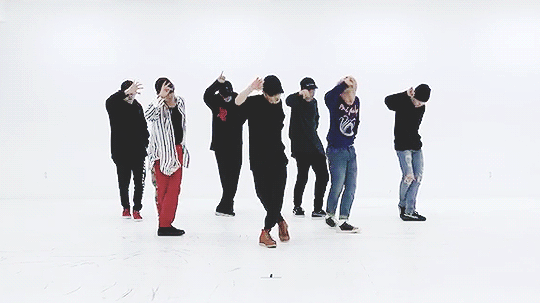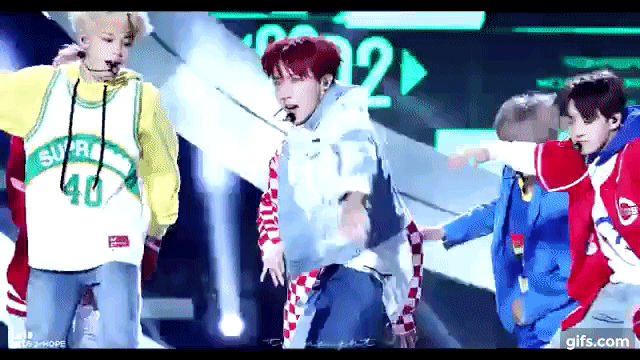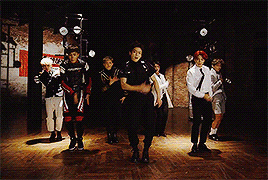Performance Review: BTS – DNA
- Kerry
- Sep 29, 2017
- 7 min read
It’s “DNA” time, baby and boy, are there a lot of stages to choose from. So in today’s review of “DNA”, I am taking into consideration all of the different iterations, including the MV, the dance practice and the music shows. Let’s go!
BTS has a history of performing innovative and interesting choreography for their title tracks. In the last two years, BigHit Entertainment (BTS’s management company) has brought in outside choreographers to create these dances.
The boys work most often with Keone and Mari Madrid, a powerhouse hip hop couple. The Madrids are based in the States but travel all around the world teaching workshops, guest choreographing, and starring on dance reality shows. They’re responsible for creating such BTS dances as “Fire,” “Not Today,” “Dope,” and “Blood, Sweat & Tears.” It’s no surprise that, according to Keone Madrid, they contributed choreography for the outro of “DNA” as well.

The BigHit performance director and BTS’s dance teacher, Son Sungdeuk, also had a huge part in choreographing “DNA.” Sungdeuk has been with BTS from the beginning and works with them consistently. He is also the brain behind “Run,” “I Need U,” and “Danger,” to name just a few.

Although it hasn’t been specified by BigHit Entertainment or BTS, (information about choreographers in K-pop is horrendously difficult to find), I believe Sungdeuk is responsible for the choreo leading up to the outro. In their Vlive Comeback Special, the members praised Sungdeuk for working on this piece for 10 days straight with little sleep.
“DNA” is a song that is enhanced by its live stage. Even though BTS claims that this is their hardest choreography yet, each member dances with ease and even marked improvement from their last comeback in February.
(Note: I’d like to give a special shout out to Kim Seokjin, the eldest member. He went from permanent wing to holding his own against the most talented dancer of the group. Every time I watch him dance, I am impressed by his growth.)

Jin (right)
The performance begins like the song, relatively calm and simple. The seven of them, with Jungkook center, engage in some clean footwork and shoulder pops for a few counts of eight.

Six members then exit stage right and left, leaving V center. After V’s first verse, in which he has a short dance solo, J-Hope enters from stage left. The two pass each other and at the last second grab hands, pulling each other back.

This push/pull movement, which physically connects V and J-Hope’s verses, is repeated in other parts throughout this choreography. There are multiple times that the boys react to each other with their movements as the song progresses from one member’s line to the next.
We see another choreographed connection when Jungkook and V dance together before the first chorus. Their duet begins when Jungkook lays his hand on V’s shoulder, they rock towards each other and then Jungkook pulls past V, causing them both to rotate around each other. At the end, they share a high five before Jimin runs in.
Another physical link is seen after the first chorus as Jimin finishes his lines. He and Suga grasp hands and Jimin sends a wave down his arm which is picked up Suga. This movement sets off his rap.

We also see cause and effect choreography that doesn't use physical contact at all. Throughout V and Jungkook’s duet, they dance together but always in opposition. It’s almost like they’re two magnets. Each movement one person does has a direct effect on the other.
Another example occurs when Jin begins his verse. As he runs out from the group, the six other members jump slightly to new positions, changing the directions they are facing.

In two points during the choreo, a motion passes from one member to the next in a wave. This happens during the first and second chorus after “무한의 세기를 넘어서 계속” (“To go on for infinite centuries”) when, starting at the center and moving down the line, the members punch upwards at the sky with both arms.

The wave is repeated again during the outro, after the final “우연이 아니니까” (“Because this isn’t coincidence”). This time it is a ticking pose that flows down the line.

This cause and effort choreography is reflective of the song lyrics. On the surface,“DNA” is about two lovers who are meant to be together from the beginning of time. BTS sings “All this isn’t coincidence” implying the lovers’ path to be together has already been predestined. On stage, this metaphorical chain of events is emphasized in the constant flow amongst the members. There is no stopping the domino effect as each motion ripples through the members, just as the lovers’ meeting cannot be prevented.
On another level, the choreography of “DNA” also plays upon the actual structure of the molecule. DNA, as the makeup of all living creatures, is composed of multiple parts that work in tandem. The concept of DNA itself is seen in the MV and stages in many ways. The most obvious is the moment in which the members grasp hands to form a double helix. It’s a brilliant piece of choreography, simple and instantly recognizable.

“DNA” definitely lives up to the expectation of a title track performance.
Keone Madrid’s section is powerful and challenging. According to V during their VLive Comback Show, it took BTS four hours to master this particular move. (Well, J-Hope got it in 10 minutes, but we won’t count the dance captain.)

But Son Sungdeuk’s choreography is the real force behind the success of this stage. Sungdeuk once said in an interview, “It’d be great if people would look more closely to the story the members are telling with their dance… When creating choreography, my style is that I always match it with the lyrics… I want to create a stage where people are able to see and hear the same story (between the dance and the song lyrics).”
With the “DNA” stage, Sungdeuk successfully translated the lyrics into movement that aligns with the message of the song.
Personally, the live stages of “DNA” greatly improved my feelings toward the song. My first listen had me worried that BTS was attempting to create more westernized songs, as this track strays far from their usual sound.
It’s not an unfounded worry. Ever since BTS was nominated for, and won, the BIllboard Music Award for Top Social Artist, the question of a United States debut keeps popping up. Their recent collaborations with western artists such as Wale and The Chainsmokers suggests that they might be moving in that direction. As they steadily grow in popularity, particularly with their English speaking audience, it’s a natural path the group might take.

Rap Monster (BTS) collaborated early in the year with American rapper, Wale, on song “Change.”

BTS and The Chainsmokers worked together on "Best of Me," a song on Love Yourself: Her.
BTS is well aware of this pressure. However, there are certain things to expect if they sign with a western music label. The item on the forefront would be the production of songs sung entirely in English. How else would they appeal to an audience that doesn’t speak Korean?
For the time being, BTS has no plan to break into the English language music industry. In April 2017, Bang Si Hyuk, CEO of BigHit Entertainment, was asked about this very possibility. He responded, “I'm not a believer in releasing full English songs to the U.S. market, like many K-pop artists have… We're adjusting and improving the way we do shows on the tour to meet the international or global level and expectations so that anyone, regardless of their culture and background, can enjoy BTS music and performances."
This is what the western music industry doesn’t understand. The language of k-pop songs is beside the point. While many do enjoy the language itself, it’s not the main reason international fans become avid followers of these groups. Fans connect most with the sentiment of the songs, the performances and the musical production. I think it allows people to transcend language and connect to a wider universe of music, coincidentally one of the messages BTS puts forth in “DNA.” (How bow dah?)
If BTS were to abandon Korean language in their music and only produce songs in English, they would fail to fulfill their oft-said promise to work hard for fans all over the world, while still remaining true to their Korean roots.
After watching the comeback show performance of “DNA,” however, and looking a little more deeply into the choreography, I started to forget my initial worries about the title track.
I began to understand that the production of the DNA stage is a story within itself. Yes, it illustrates the universality of all humans and our connection to one another. But it also reassures the fans that BTS will never forget what got them here.
What I didn’t mention above is that there are multiple recycled dance moves in the DNA stage. These are all included in the choreography of “DNA” but have been used previously in another BTS dance.
There is a piece of Jungkook’s solo from “Not Today.”
“DNA” and “Not Today”
We can see the footwork from “Spring Day” in the outro.
“DNA”and “Spring Day”
The classic opening from “Blood, Sweat and Tears” is included.
“DNA”and “Blood, Sweat & Tears”
A dance move from “Dope” can be seen.
“DNA” and “Dope”
Jin’s powerful fist raise from “Fire” is featured.
“DNA” and “Fire”
And there’s a revisit to Namjoon’s “kiss me” from “Blood, Sweat & Tears.”
“DNA” and “Blood,Sweat & Tears”
There are no coincidences in this song or its choreography. The choreographers, most likely Son Sungdeuk, worked these moves into the piece for a reason. They’re peppered throughout the dance like little Easter eggs. But they also mean so much more.
In a new song that is vastly different from BTS's other work, these hidden dance gems act as a security blanket for their global fanbase. Their inclusion tells fans that BTS has not forgotten their roots. Even though BTS is exploring new territory with their music, it doesn’t mean they are leaving Korean music, or their fans, behind. Instead, they are inviting us to trust them on this journey as they step out into a brand new music world.
There are so many layers to the “DNA” stage. My opinion is only one interpretation. Maybe you disagree or maybe you couldn’t agree more. Is this just a stage with some pretty nifty choreo, or is it a message to BTS’s fans? Let me know your thoughts!
Overall thoughts:
Overall, my biggest takeaway from these reviews was that there needs to be more of an appreciation for those behind the idols. Finding information about these dances was challenging. The K-pop industry needs to recognize those who make them successful. This should include choreographic credits.
BTS is slaying this comeback. Every stage they have had has been extremely well put together. The boys keep improving in their dancing skills. I can’t wait to see what is thrown at them next.
























Comments